Friday Night Funkin
Dies ist eine englischsprachige Spielanalyse zum Spiel Friday Night Funkin', durchgeführt von Weib Check.
The following is an analysis of the game Friday Night Funkin', produced by Weib Check.
| Friday Night Funkin' | |
|---|---|
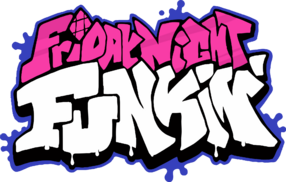 | |
| Logo of the game Friday Night Funkin' | |
| Studio | Funkin' Crew |
| Publisher | N/A |
| Leitende Entwickler | Ninjamuffin99 |
| Erstveröffent- lichung | 1.11.2020 |
| Plattform | Browser, Windows, Linux, MacOS |
| Spiel-Engine | HaxeFlixel |
| Genre | Rhythm |
| Spielmodus | Singleplayer |
| Steuerung | Gamepad, Keyboard |
| Sprache | English |
Motivation
What’s special about it?
Friday Night Funkin' is an odd game for a variety of reasons; mostly, however, because it appears to exist out of its own time. A game with the aesthetic, mechanical and cultural sensibilities of 2007, catapulted to enormous popularity among a demographic which never experienced most of that decade first-hand.
It is chock full of references to the website Newgrounds, which was the earliest popular adoption of the "portal" format. Users could upload their own content - artwork, music, animations, and most famously browser games. The site became very popular and developed an insular culture, primarily composed of western male teenagers, some of whom maintain internet creator careers to this day (Arin Hanson, Chris O'Neill and Ross O'Donovan among others).
The ease of access presented by the Adobe Flash engine meant many independent creators could make animations and small browser games with vector graphics[1], leading to the proliferation of a specific art style that remains recognizable to this day.
Notable here is the recent renaissance of several games in this style with roots in Newgrounds, especially with younger audiences: Friday Night Funkin', Among Us and the Henry Stickmin series being the largest at time of writing.
Friday Night Funkin' was originally an entry for the Ludum Dare '47 game jam in 2020. It was expanded into a full project and a playable demo was made available in 2021, which received massive attention rapidly; according to Google Trends, it hit its peak popularity in June of that year, and has maintained high interest since then[2].
The game is, on its face, quite simple; there is no complex narrative, the full range of surface level interaction provided can be experienced in a few seconds, and the graphics are, if not ugly, very simple - plus, they hearken back to an era many of its players would have no memory of. What, then, makes it so appealing to an audience of teenagers? These are some of the questions that drove our interest in analysing the game.
Are similar games available?
Friday Night Funkin' is a pastiche of older rhythm games. The biggest and most obvious inspiration is Dance Dance Revolution, from which it borrows the directional arrow control scheme - played here on a keyboard or controller, not a custom pad meant to encourage dancing. In this sense, it also resembles Guitar Hero, where the inputs are finer and faster than those of DDR, often requiring quick fingerwork.
The structure of the game's many "battles" seems closely tied to PaRappa the Rapper, where different foes in colourful settings rap verses which the player counters in a call-and-response fashion.
In sentiment, the game resembles the Tony Hawk's Pro Skater series. Both the by now quite dated "urban cool" slang and set dressing and the paper-thin story with no regard for anything but looking cool, pulling off difficult manoeuvres, and getting a high score seem to bind the two together.
In its basic genre, being a rhythm game, there are many other titles it resembles: The osu! and Rhythm Heaven series come to mind. In terms of lightweight design and youth appeal (as well as some musical choices), the mobile game Geometry Dash is also similar.
Theme
What is the theme of the game?
The main theme of the game is a classic hero-fights-for-girl situation, though it serves little more purpose than as an excuse to have music battles. The main character’s primary goal is defeating other (non-playable) characters, including the girlfriend’s parents, to prove himself worthy of his girlfriend. Being a good rapper and/or musician seems to be the ultimate status symbol in this world.
The game is quite playfully macho. The character Pico waves around a comically large gun, the demonic father wears a suit jacket over his bare chest, and the entire concept of the rap battle encounters calls back to an era of high testosterone MTV music videos.[3]
How is the theme communicated to the player?
Primarily through backdrops and flourishes during gameplay: The girlfriend cheers you on, especially when doing well, and failure shows an embarrassing graphic. Two characters are, by the titles of their encounters (Daddy Dearest and Mommy Must Murder respectively), implied to be the girlfriend’s demonic parents.
Are there any references to other media concerning the theme?
In its own way. The game's fundamental story is archetypical to an almost parodic level; as such, it feels like it's referencing titles such as Super Mario by its very existence.[4]
Player Experience
What does the player feel?
Players experience mostly libidinal emotions: It's easy to enter a flow state when doing well, where inputs no longer have to be consciously registered before execution.[5] On the flip side, it's equally easy to be overwhelmed and quickly fail, which the game playfully mocks you for.
Playing well can feel exhilarating; poor play can become frustrating. To compensate for this, there are three different difficulty settings, which can be chosen freely. These alter nothing about the game other than the sequence and challenge of the inputs.
What elements contribute to the experience?
Primarily a very loud and colourful artstyle, as well as the music; It’s fast and synthesised, and alludes to various styles common in the past two decades, from Nu Metal to EDM to Hyperpop and Jack Stauber. Basically everything on screen will be moving at any given time, usually in rhythm.
Does the experience change during the game?
Some tracks are more difficult than others (this is a little rough at times). There are different “encounters” that change the mood – two notable antagonists are horror-themed, one is an aesthetic reference to anime dating simulators.
-
Monster
-
Spirit
-
Senpai
Story
What is the main story?
The original Ludum Dare prototype's description outlines the story as follows:
"Uh oh! Your tryin to kiss ur hot girlfriend, but her MEAN and EVIL dad is trying to KILL you! He's an ex-rockstar, the only way to get to his heart? The power of music..."[6]
Beyond this, however, the game largely doesn't have a traditional story, especially during gameplay.
Games of emergence and games of progression
The game is strictly non-narrative. The story mode has elements of progression (seeing the second and third song in a given “week” requires beating all the songs – however, weeks can be beaten out of order); in this sense, there is also emergence, as there is a fail state that players must overcome.
How is the story communicated?
In the current demo version, the story is largely absent. Character and background designs vaguely hint at a story at times, but the only way to get a gist of the narrative is by paying attention to the song or week titles (as mentioned earlier, “Daddy Dearest” and “Mommy Must Murder” imply the antagonists of these weeks are someone’s parents) or by reading external sources, like the summary on the game page, the creators’ twitter accounts, or the Friday Night Funkipedia, a fan-run lore wiki.
Setting
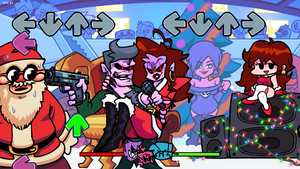
What is the setting of the game?
The game takes place in a modern world with additional fantasy elements like demons and other inhuman creatures. Characters in the setting appear ready to engage the Boyfriend in rap battles at the drop of a hat.
Throughout the different stages the game takes place in different environments like a music stage, a spooky room, a christmas-themed shopping mall, somewhere in a town/city, the top of driving limousines, the front of a cliché anime school and a battle ground.
How is the setting communicated?
Through Backdrops and Character Design, as well as the character's personalities and musical stylings.
Are there references depicted from real life?
Many references to old newgrounds content and creators such as Arin Hanson and Chris O’Neill, and fictional characters like the old de-facto mascot “Zone-Tan.” Several newgrounds characters are even battles in and of themselves.[7]
There are no specific references to real-life events or locations; the closest would be that some encounters take place in malls, schools and on highways, and three songs take place during Christmas.
Character

What or who is the protagonist of the game?
The Protagonist is only referred to as “Boyfriend,” and several fan-assigned names have specifically been debunked by the creators. He is a small man with blue hair, baggy pants, a white t-shirt with a simple motif, comically large shoes and a cap which he wears backwards.
What are the characteristics of the character?
"Boyfriend" seems to put on the facade of someone who is an outwardly confident and cocky character, yet the player knows this to not be true since both small and big failures undermine his ego. He sulks a lot as a result.
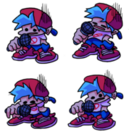
Can the player relate to the character? Why?
He is a conduit for the player's inputs; he reacts with exaggerated visual flourishes to failures on the player's part (the entire sprite freezes for a moment, and shifts to a dark purple hue). Beyond this, his basic mission - impressing his partner - is relatable to many.
Objectives
What is the main goal of the game?
The game has no external rewards or punishments. The levels do not have to be unlocked and can be played in any order, the difficulty can be adjusted to easy with no punishment for doing so. There are scores, but they are unceremoniously displayed in the menu and do not change anything about the game experience.
This means the player’s incentive in playing the game is completely dependent on the gameplay aspect and largely self-imposed. This works out well with the few distinct functions of the game play - while playing well, you get to hear the character singing the tune, and when messing up the character freezes up and the melody cuts out. The objective is less just to get to the end of the game, but to play the game (and do it well).
Does the game include any sub goals?
Other than finishing the songs, there is a high score display and all songs can be played in hard mode. As of March 2022, the game is not yet finished; there may be further goals in future updates.
Procedures
How can the player carry out actions in the game?
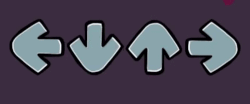
The arrows which move up the screen during gameplay have to be matched in time with directional keys (a joystick also works); this makes the Boyfriend character sing notes. Missing notes or hitting them at the wrong time will make him “choke.” These actions add and subtract from the level score, and shift the "health bar" at the bottom of the screen one way or another.
How can the character be controlled?
Directional keys (Arrow keys and WASD). Menus are additionally navigated using the enter key.
Basic resources
What are the basic resources in the game?
There is a “health bar,” where the enemy and the player jostle for control. Getting pushed all the way to the right by repeatedly making mistakes results in a failure state, pushing it all the way to the left does nothing except increase the buffer room and insulate against failure.
This creates a feedback loop where doing well can compound, making it very satisfying (at the cost of making repeated failure very immediately punishing). The only other metric for success is a high score.
What is the relation between the resources?
Doing well leads to both a higher score and an increased “health” pool.
What is the nature of the resources?
See above.
Conflict
Does the game provide any conflicts?
By its very nature: The stages are a series of rap battles against colourful adversaries.
What is the nature of these conflicts?
They are relatively low stakes and performative; No one appears to ever be in danger. It is not a very serious game.
How can the player resolve the conflicts?
Beating the stages appears to resolve the conflicts, though this is implied only - nothing is ever shown on screen explicitly.
Are other players involved in the conflict?
The game is single player; in terms of involved fictional characters, the girlfriend is consistently present, though she barely interacts with anyone.
Outcome
What are the results of the game?

Failure in a given stage results in a jokey, embarrassing graphic showing the boyfriend dropping his microphone in shock, stylistically electrified. He is shown with “blue balls.”
Winning results in nothing, unless a high score is beaten, in which case this is recorded. Since the game is not officially finished, an ending to the game might be added.
What are the victory conditions?
Not failing a given song; the game doesn’t provide any additional primary motivations.
What are the defeat conditions?
Missing enough notes or playing wrong notes during a song.
Visual Style
What is the visual style of the game?
Everything is rendered in a very off-the-cuff vector style, like many old Flash games. (Note that this is common in other titles which share FNF's heritage, such as Among Us). Sprites are frequently rotated and moved instead of completely redrawn, to give the game more bounce and vibrance without much development cost.
The game utilises many bold and primary colours, with thick black outlines. The character designs are heavily cartoonish and exaggerated (Note, again, that many of the characters were created in the heyday of the newgrounds forum, where styles developed within the limitations of the Adobe Flash engine, inspired by 90s anime as well as western cartoons and graffiti street art). For reference, see popular animations of the time, such as Arin “Egoraptor” Hanson’s Metal Gear Awesome and Girl-Chan in Paradise, or Edd Gould's Eddsworld.
Are other games referenced?
Other games are referenced throughout, most directly in the winter mall stage, where games from popular flash titles are represented in the background – notably Super Meat Boy.
Is the art style inspired by real life?
No. It is very cartoonish.
Additional Analysis
The Community
Friday Night Funkin’s type of popularity is particularly interesting. The game’s most vocal fanbase is composed of teenagers, which is especially noteworthy since the game heavily references media created before those teenagers were even alive.
The community also celebrates neurodivergence. The creators have claimed that the central characters Boyfriend and Girlfriend have ADHD[8] and a side character has Schizophrenia[9], and the community itself includes a lot of neurodivergent people. The game’s design elements and mechanics may have something to do with this phenomenon.
The game’s loud and catchy music, the saturated colours, energetic animations and fast pacing can be an overstimulating experience for anyone not used to it, but it is exactly the type of media that has become a staple of this community (other examples would be music by 100gecs or various vocaloid artists). This could relate to the practice of managing understimulation by consuming media with strong stimuli, common with some neurodivergent people.[10]
It's of note that Friday Night Funkin' community interaction happens fully online, and with the game’s fairly recent release mostly includes teens who have gotten used to fast-paced media via TikTok and other social media platforms. The modern internet operates with people’s attention spans as currency. Most platforms try to get their user bases addicted with systems not unlike gambling, and severely diminish their attention span in the process. No one truly knows this like today’s children, who have made this new internet their home. This short, fast-paced and stimulating game feels natural to them and the media environment they are growing up in.

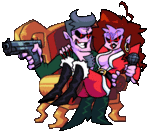
Sexism
As may already be a given for the time and internet niche, the game features mild to strong sexism. Almost all female characters are shown in skimpy outfits, and the only female antagonist is basically undressed on her husband’s lap by the end. It is worth noting, however, that she is portrayed as threatening in the same way the father is – she definitely has agency, but sexualization is ubiquitous.
This doesn't extend into the pornographic; When a character is sexualized, it doesn't appear to be explicitly for the purpose of titillation. Perhaps it is simply a product of its origin in the cultural milieu of Newgrounds in the 2000s.

Modding
Friday Night Funkin’ is an easily moddable game. The creators have published the files for the demo versions on GitHub, along with a licence that any and all mods are permitted, as long as they’re open source. Many people have taken to creating their own stages, replacing characters, adding difficulties, and even modding in new songs for existing characters. The culture that developed around it is so vibrant, that the community has set up a new, secondary Friday Night Funkipedia focused exclusively on mods and other fan content.
This ties into other games popular with people in a similar demographic, like Minecraft, Terraria, or Stardew Valley, all of which have a massive modding culture. The game is intentionally easy to mess with, in a way most (if not all) AAA releases haven’t been for a long time.
Future Full Game
The current Friday Night Funkin’ game available is an improved version of an earlier build, now known as the “Prototype.” After FNF blew up in popularity, the creators launched a Kickstarter campaign to create a fully finished game currently titled “Friday Night Funkin’: The Full Ass Game,” with more weeks, animated cutscenes, multiplayer options, and much more. The game reached its goal within two hours of announcement, and successively exceeded them in its month of runtime. FNF:TFAG is now in development.[11]
References
- ↑ Warren, Christina (19.11.2012): "The Life, Death and Rebirth of Adobe Flash." Mashable, retrieved 6.3.2022
- ↑ Google Trends. Retrieved 06.03.2022
- ↑ Arthur, Damien. "Hip Hop Consumption and Masculinity." 2006. University of Adelaide. Retrieved 6.3.2022.
- ↑ Sherman, Sharon R. "Perils of the Princess: Gender and Genre in Video Games." 1997. Western Folklore. Retrieved 6.3.2022.
- ↑ Seger, Jeff & Potts, Richard. "Personality Correlates of Psychological Flow States in Videogame Play." 3.5.2012. Current Psychology. Retrieved 6.3.2022.
- ↑ Funkin' Team. Description on website. 2020. Retrieved 6.3.2022.
- ↑ Woodrick, Sam. "All Guest Appearances in Friday Night Funkin." 12.2.2021. GameRant. Retrieved 6.3.2022.
- ↑ Stated by developers during a livestream. Retrieved 6.3.2022.
- ↑ Fulp, Tom. "Pico's World." Original unavailable and deprecated, see gameplay video. 2002, Newgrounds. Retrieved 6.3.2022.
- ↑ Bioulac. Stéphanie Et al. "Attention deficit/hyperactivity disorder and video games: A comparative study of hyperactive and control children." 16.04.2020. Cambridge University Press. Retrieved 6.3.2022
- ↑ Confirmed on Kickstarter by developers, Funkin' Crew. "funkin funded." 20.6.2021. Retrieved 6.3.2022.
External Links
- Friday Night Funkin' on Itch.io
- Friday Night Funkin' on Newgrounds
- Friday Night Funkin' Source Code on GitHub
- Original Friday Night Funkin Entry for Ludum Dare '47
- Ludum Dare 47
- Friday Night Funkipedia
- Friday Night Funkin' Mods
- The Newgrounds Website
- Among Us
- The Henry the Stickmin Collection
- Zone-Chan on KnowYourMeme.com
- Metal Gear Awesome
- Girl-Chan in Paradise
- Eddsworld
- The FNF:TFAG Kickstarter Campaign



